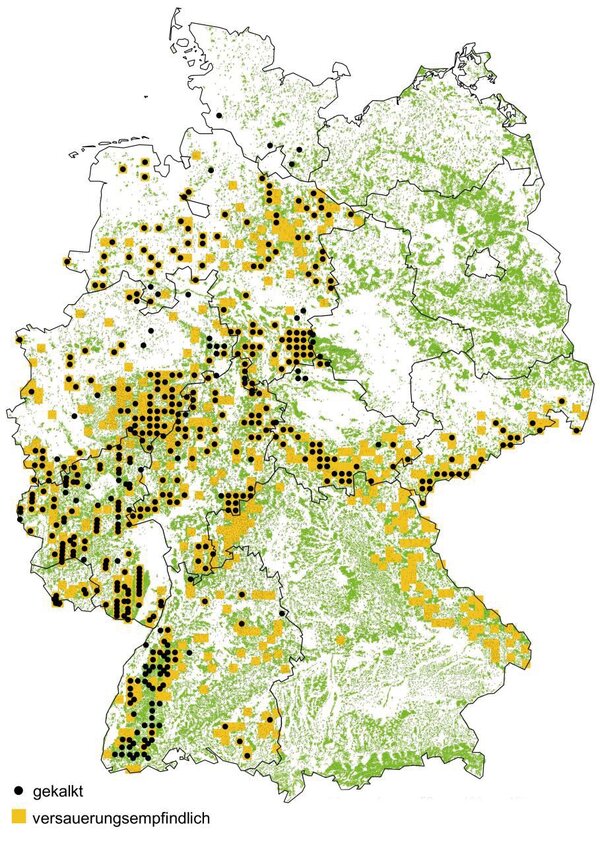Expertise
Against acid soil: What forest liming does
Nicole Wellbrock | 01.12.2016
Since the early 1980s, more than 3.2 million hectares of forest have been limed in Germany. This was intended to counteract further area-wide soil acidification and loss of soil quality. As the findings of the second forest soil condition survey show, soil protection liming has significant effects on soil condition and ground vegetation.

When it comes to soil acidification, many people first think of the "acid rain" which has dominated media coverage over the past decades during the forest dieback debate. But a certain degree of soil acidification is a natural process. Even precipitation water naturally has a slightly acidic pH of 5.6 because the carbon dioxide (CO2) in the air dissolves in the raindrops. The resulting carbonic acid is carried into the soil as a weak acid via the precipitation. Acids are also formed in the course of the conversion of organic matter by the soil fauna.
However, since industrialization, significantly more acid-forming substances have been introduced into our forests, so that the processes take place more quickly. For this reason, compensatory liming has been carried out since the 1980s as a preventive soil protection. Normally, dolomite rock flour is applied (approx. 3 t/ha), which also supplies the important macronutrient elements calcium and magnesium.
Where is liming done and where is it not done?
Since forest management is in the hands of the federal states, each state has developed its own regulations on liming. Depending on the site conditions, these differ significantly from one another in some cases. There are federal states that do not liming at all, others liming very frequently.
The acidification-sensitive sites officially designated by the federal states include those that can be limed according to certain criteria. Of the total 1,859 inventory points in the national forest soil survey (BZE II), 749 sites were classified as acidification-sensitive. Since the first forest soil survey (BZE I), 385 of these sites have been limed at least once. The evaluation of the BZEs on liming thus refers only to the comparison of limed and non-limed inventory points that were classified as acidification-sensitive.
What happens in the soil

Comparing the two surveys (BZE I and BZE II), it can be seen that pH and base saturation, as indicators of nutrient availability, increased more on the limed soils than on the unlimed ones. At the same time, aluminum concentration decreased. Limed soils showed a significantly higher increase. In the mineral soil below 30 cm, acidification continued to progress on unlimed sites, while this was reduced or halted on many limed sites.
The increase in calcium levels, as well as a higher pH on the limed sites, stimulates microbial activity and increases the occurrence of so-called primary decomposers such as earthworms, millipedes, and isopods. Their activity causes more organic matter to be converted in the overlay. As a result, organic matter decreases there, while organic matter increases in the underlying mineral soil. Many substances, such as nitrogen and heavy metals, are bound to the organic matter, about 50% of which consists of carbon.
Liming therefore affects the carbon, nitrogen and heavy metal stocks of the soils. Although all soils store carbon, limed sites store significantly more. For nitrogen, stock losses are significantly lower on limed sites. The heavy metals transferred to the mineral soil are bound there comparatively firmly, so that there is basically no risk to groundwater.
Soil protection liming also leads to a change in the species composition of the vegetation. Limed areas showed a higher number of species in the grove-simple beech forests and in spruce forests on soil-acidic solid rock. However, the species were often untypical of the forest margins and clearings.
Further efforts needed
Soil protection liming is intended to ensure functional and stable forest ecosystems. Although liming compensates for acids in the soil and increases the supply of nutrients, it cannot restore the original condition of forest soils. In addition to the drought factor, the main cause of changes in forests is the oversupply of nitrogen, which leads to imbalances in forest nutrition. Therefore, air pollution control, especially the mitigation of nitrogen emissions as the root cause of soil acidification, is probably the most important measure to maintain healthy forests.
Service zum Download
- Thünen Report 43 (in German)Dynamik und räumliche Muster forstlicher Standorte in Deutschland – Ergebnisse der Bodenzustandserhebung im Wald 2006 bis 2008






